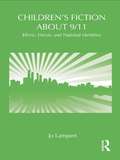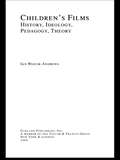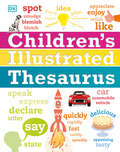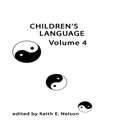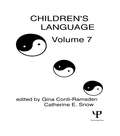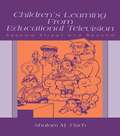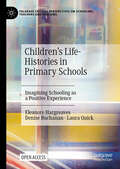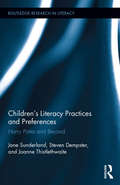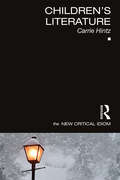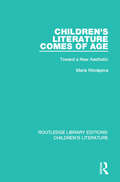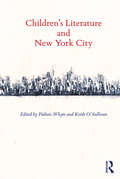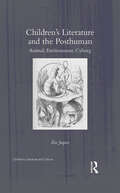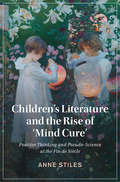- Table View
- List View
Children's Early Text Construction
by Lauren B. Resnick Clotilde Pontecorvo Margherita Orsolini Barbara BurgeFor decades, research on children's literacy has been dominated by questions of how children learn to read. Especially among Anglophone scholars, cognitive and psycholinguistic research on reading has been the only approach to studying written language education. Echoing this, debates on methods of teaching children to read have long dominated the educational scene. This book presents an alternative view. In recent years, writing has emerged as a central aspect of becoming literate. Research in cognitive psychology has shown that writing is a highly complex activity involving a degree of planning unknown in everyday conversational uses of language. At the same time, developmental studies have revealed that when young children are asked to "write," they show a surprisingly sophisticated understanding of the representational constraints of alphabetic writing systems. They show this understanding long before they can read conventional writing on their own. The rich structure of meanings involved in the word text provided the glue that brought together a group of scholars from several disciplines in an international workshop held in Rome. Reflecting the state of the field at the time, the majority of the workshop participants were scholars working in languages other than English, especially the romance languages. Their work mirrors a linguistic and psychological research tradition that Anglophone scholars knew little of until recently. This volume provides English-language readers with updated versions of the papers presented at the meeting. The topics discussed at the workshop are represented in the chapters as follows: * the relationship between acquisition of language and familiarity with written texts; * the reciprocal "permeability" between spoken and written language; * the initial phases of text construction by children; and * the educational conditions that facilitate written language acquisition and writing practice.
Children's Fantasy Literature
by Michael Farah Mendlesohn Michael Levy LevyFantasy has been an important and much-loved part of children's literature for hundreds of years, yet relatively little has been written about it. Children's Fantasy Literature traces the development of the tradition of the children's fantastic - fictions specifically written for children and fictions appropriated by them - from the sixteenth to the twenty-first century, examining the work of Lewis Carroll, L. Frank Baum, C. S. Lewis, Roald Dahl, J. K. Rowling and others from across the English-speaking world. The volume considers changing views on both the nature of the child and on the appropriateness of fantasy for the child reader, the role of children's fantasy literature in helping to develop the imagination, and its complex interactions with issues of class, politics and gender. The text analyses hundreds of works of fiction, placing each in its appropriate context within the tradition of fantasy literature.
Children's Fiction 1900–1950 (Routledge Revivals)
by John CooperFirst published in 1998, this volume explores how the genre of school stories had become firmly established by the turn of the twentieth century, having been built on the foundations laid by writers such as Thomas Hughes and F.W. Farrar. Stories for girls were also taking on a more exciting complexion, inspired by the ‘Katy’ books of Susan Coolidge. The first five decades of the twentieth century saw further developments in children’s fiction. In this comprehensive volume, John and Jonathan Cooper examine each decade in turn, with alphabetically arranged entries on popular children’s writers that published works in English during that period. 206 different authors are covered, many from the United States and Canada. Each entry provides information on the author’s pseudonyms, date of birth, nationality, titles of works, place and date of publication and the publisher’s name. The artist responsible for a book’s illustrations is also identified where possible. With over 200 illustrations of cover designs and dustwrappers, many of which are now rare and have never before been published, this book will delight collectors, dealers, scholars, librarians, parents and all those who simply enjoy reading children’s fiction.
Children's Fiction about 9/11: Ethnic, National and Heroic Identities (Children's Literature and Culture)
by Jo LampertIn this pioneering and timely book, Lampert examines the ways in which cultural identities are constructed within young adult and children’s literature about the attacks of September 11, 2001. Looking at examples including picture books, young adult novels, and a selection of DC Comics, Lampert finds the co-mingling of xenophobia and tolerance, the binaried competition between good and evil and global harmony and national insularity, and the glorification of both the commonplace hero and the super-human. Specifically, Lampert identifies three significant identity categories encoded in 9/11 books for children--ethnic identities, national identities, and heroic identities--arguing that their formation is contingent upon post-9/11 politics. These shifting identities offer implicit and explicit accounts of what constitute good citizenship, loyalty to nation and community, and desirable attributes in a Western post-9/11 context. Lampert makes an original contribution to the field of children’s literature by providing a focused and sustained analysis of how texts for children about 9/11 contribute to formations of identity in these complex times of cultural unease and global unrest.
Children's Films: History, Ideology, Pedagogy, Theory (Children's Literature and Culture #Vol. 2165)
by Ian Wojik-AndrewsThis study examines children's films from various critical perspectives, including those provided by classical and current film theory.
Children's Illustrated Thesaurus (DK Children's Illustrated Reference)
by DKExpand and explore your vocabulary.Discover a whole new vocabulary and never be lost for words again, with this comprehensive and detailed illustrated children&’s thesaurus, with synonyms and antonyms for more than four thousand main entries. This beautifully illustrated thesaurus for kids age 9 and older is packed with: • A comprehensive, illustrated thesaurus created specifically for young readers and writers • Authoritative content from Collins is given the DK treatment to make the pages lively and the words meaningful for children • Fun and fresh illustrated &“word features&” to explore and expand on vocabulary This colorful and insightful thesaurus contains more than four thousand entries, where each entry is supported by a definition and example sentence to help boost a child&’s confidence inusing and choosing words. An imaginative mix of photography and illustration gives the book great visual appeal and is the perfect book for children who enjoy words; or who need a little extra help or encouragement with their English vocabulary.Each entry provides information about each headword: the word type (e.g. noun); definition; example sentence; list of synonyms; further (more advanced) synonyms and antonyms. It also includes synonyms from Australia, New Zealand, Scotland, South Africa and the U.S. The Children&’s Illustrated Thesaurus is not only a fun and vibrant educational tool for children, but is also perfect for educators looking for a learning tool to inspire vocabulary development.Expand your library collection and pair this exciting learning tool with DK&’s ever-popular Children&’s Illustrated Dictionary.
Children's Language: Volume 10: Developing Narrative and Discourse Competence (Children's Language Ser.)
by Ayhan Aksu-Koç Keith E. Nelson Carolyn E. JohnsonThese volumes present coherent sets of papers developed along two of the thematic lines that underscored the program of the meeting of the International Association for the Study of Child Language in Istanbul in the summer of 1996. Thoroughly reviewed and updated to reflect the state of child language research and theory--particularly in the domains of discourse and interaction--they convey not only the flavor of that meeting but some of the most exciting trends in the field today. Each contribution in Volume 10, Developing Narrative and Discourse Competence, focuses on the differential effects of discourse genres, elicitation techniques, communicative contexts, literacy and schooling, and the oft-cited variables of age, language, and culture. Issues concerning the interrelations between social, cognitive, and affective capacities and processes in discourse are addressed. Each chapter raises theoretical questions regarding how and when representations are constructed to support new complexities. Presenting data from a cross-cultural and cross-linguistic perspective, this volume highlights both the particulars and the universals of the processes involved. The chapters in Volume 11, Interactional Contributions to Language Development, address issues including scaffolding of processing and learning in particular interactional sequences; linkages among interpersonal functions or relations, cognitive development, and semantic, syntactic, and pragmatic devices or forms; and models of how interactions proceed, input is selected, and learning advances across multiple rounds of interaction. Each of these volumes will be a valuable addition to the libraries of all who study the development of language.
Children's Language: Volume 11: Interactional Contributions To Language Development (Children's Language Ser.)
by Ayhan Aksu-Koç Keith E. Nelson Carolyn E. JohnsonThese volumes present coherent sets of papers developed along two of the thematic lines that underscored the program of the meeting of the International Association for the Study of Child Language in Istanbul in the summer of 1996. Thoroughly reviewed and updated to reflect the state of child language research and theory--particularly in the domains of discourse and interaction--they convey not only the flavor of that meeting but some of the most exciting trends in the field today. Each contribution in Volume 10,Developing Narrative and Discourse Competence, focuses on the differential effects of discourse genres, elicitation techniques, communicative contexts, literacy and schooling, and the oft-cited variables of age, language, and culture. Issues concerning the interrelations between social, cognitive, and affective capacities and processes in discourse are addressed. Each chapter raises theoretical questions regarding how and when representations are constructed to support new complexities. Presenting data from a cross-cultural and cross-linguistic perspective, this volume highlights both the particulars and the universals of the processes involved. The chapters in Volume 11, Interactional Contributions to Language Development, address issues including scaffolding of processing and learning in particular interactional sequences; linkages among interpersonal functions or relations, cognitive development, and semantic, syntactic, and pragmatic devices or forms; and models of how interactions proceed, input is selected, and learning advances across multiple rounds of interaction. Each of these volumes will be a valuable addition to the libraries of all who study the development of language.
Children's Language: Volume 4 (Children's Language Series)
by Keith E. NelsonFirst published in 1983. This series, Children’s Language, reflects the conviction that extensive work on entirely new fronts along with a great deal of reinterpretation of old-front data will be necessary before any persuasive and truly orderly account of language. For all volumes in the series there is a common scheme of operation with two tactics. First, to give authors sufficient planning time and freedom to arrive at a chapter-length account of their area of thinking which vividly shows both the progress and the problems in that area, with the author of each chapter free to find a workable proportion of new experimental contributions, review, and theory. The second tactic concerns the selection of topics for each volume. This is Volume 4. Structures about language and thought and children as employed in certain other fields may well be shaken and stimulated, particularly in education, sociology, anthropology, literature, and language remediation.
Children's Language: Volume 5 (Children's Language Series)
by Keith E. NelsonFirst published in 1985. In children’s language we are in search of the “ great bears,” the clear solid patterns that hold up after countless angles of view and after many, many lenses have been tried. In the first four volumes of this series, Children's Language, there has been coverage of alternative theories and methods in syntax, semantics, discourse, phonology, figurative language, second language learning, the transition to text processing, and story structures, among other topics. In order to present a lively account of development, the authors in the first four volumes were encouraged to each adopt a flexible format—one that best fit their own material rather than sticking to a standard review organization. Exactly the same approach has been taken by the authors of the present volume 5.
Children's Language: Volume 6 (Children's Language Series)
by Keith E. Nelson; Anne van KleeckThis series, Children’s Language, reflects the conviction that extensive work on entirely new fronts along with a great deal of reinterpretation of old-front data will be necessary before any persuasive and truly orderly account of language development can be assembled. None of the chapters are simply reviews, and none of the volumes are " handbooks" or " reviews" or introductory texts. Rather the volumes try to capture the excitement and complexity of thinking and research at the growing, advancing edges of this broad field of children’s language. In line with these goals for the Children’s Language series the present volume includes coverage of a fairly wide range of topics and subtopics. The authors for each chapter will weave their own story and we leave to them the introduction of their main plots and the major and minor characters in their scientific stories. This is volume 6.
Children's Language: Volume 7 (Children's Language Series)
by Catherine E. Snow Gina Conti-RamsdenThis volume presents current research findings on vital issues in language development compiled by an international group of leading researchers. The data are drawn from studies of the acquisition of Swedish, Polish, Serbo-Croatian, Hungarian, Portuguese, Italian, and English. Themes emphasized in all the chapters include the importance of the social context of acquisition, the existence of interconnections among various domains of language development, and the impossibility of understanding acquisition using a simple theory or a single methodological approach.
Children's Language: Volume 8 (Children's Language Series)
by Keith E. Nelson Zita RégerEach child is spoken to by genetic heritage and by the rich current set of interactional environments -- familial, local community, and broader cultural voices. Using past structures and paradigms of scholarship, scholars seek to understand what the child achieves in language and how. The tools available for this research are not static but evolve jointly through the sharing of information, and with each "brief moment in time" in efforts to look at children's languages "just as they are." Containing a wide range of contributions from developmental approaches to phonological ability, the lexicon, the grammar as well as conversation and sign language, this text details the interrelated research and theorizing discussed at a recent Budapest conference. The meeting of the International Association for the Study of Child Languages was particularly rich in the diversity of scholars present, which is highly appropriate because such diversity is integral to an informed study of children's language.
Children's Language: Volume 9 (Children's Language Series)
by Carolyn E. Johnson John H. V. GilbertThis volume brings together the work of 32 scholars from 13 countries -- investigations of children learning 15 different languages, in some instances more than one at a time. The scope of this work -- as broad as it is -- only partially represents the research interests and approaches of the more than 350 scholars from 34 countries who contributed papers or posters to the Sixth International Congress for the Study of Child Language. This investigative power and diversity are, for the most part, focused on topics and issues of modern day child language research that have been under discussion for the last 30 years or so. Some even go beyond that in early diary studies and philosophers' speculations. While the issues are mainly familiar ones, the 17 chapters contribute to the advancement of child language study in several specific ways. They: * represent current theoretical frameworks, both bringing the insights of the theories to the interpretation of language development and testing tenets or implications of the theories with child language data; * contribute substantively to the crosslinguistic study of child language, reflecting both the linguistic diversity of the authors themselves and a recent major shift in the approach to child language study; * build on the now considerable body of knowledge about children's language, both adding to information about the basic systems of phonology, syntax, and semantics, and extending beyond to explore aspects of narrative and literacy development, language acquisition by bilingual and atypical children, and language processing; and * contain hints of new directions in child language study, such as increased attention to the impact of phonology on other language systems. Taken as a whole, this volume reflects the current strength of crosslinguistic research, the application and testing of new theoretical developments, a new legitimacy of language disorder data, and a new appeal to the descriptive possibilities of language processing models. In addition, there is a theme that runs through many of the chapters and points the way for important research in the future: the role of prosody in the acquisition of various language structures and systems.
Children's Learning From Educational Television: Sesame Street and Beyond
by Shalom M. FischAt its best, educational television can provide children with enormous opportunities and can serve as a window to new experiences, enrich academic knowledge, enhance attitudes and motivation, and nurture social skills. This volume documents the impact of educational television in a variety of subject areas and proposes mechanisms to explain its effects. Drawing from a wide variety of research spanning several disciplines, author Shalom M. Fisch analyzes the literature on the impact of educational resources. He focuses on television programs designed for children rather than for adults, although adult literature is included when it is particularly relevant. In addition, much of the discussion concerns the effects of unaided viewing by children, rather than viewing in the context of adult-led follow-up activities. The role of parent-child co-viewing and issues relevant to the use of television in school or child care also receives consideration. This volume is intended to make the disparate literature on educational television's impact more accessible, by bringing it together into a centralized resource. To that end, the volume draws together empirical data on the impact of educational television programs--both academic and prosocial--on children's knowledge, skills, attitudes, and behavior. In addition to its emphasis on positive effects, this volume addresses a gap in the existing research literature regarding children's learning from exposure to educational television. Acknowledging that little theoretical work has been done to explain why or how these effects occur, Fisch takes a step toward correcting this situation by proposing theoretical models to explore aspects of the mental processing that underlies children's learning from educational television. With its unique perspective on children's educational television and comprehensive approach to studying the topic, this volume is required reading for scholars, researchers, and students working in the area of children and television. It offers crucial insights to scholars in developmental psychology, family studies, educational psychology, and related areas.
Children's Life-Histories in Primary Schools: Imagining Schooling as a Positive Experience (Palgrave Critical Perspectives on Schooling, Teachers and Teaching)
by Eleanore Hargreaves Laura Quick Denise BuchananThis open access book explores schooling from the perspective of children via data from a longitudinal life-history study. It questions whether schooling creates an environment where all children to flourish; or whether a policy focus on attainment in mathematics and English hinders some children’s wellbeing and learning. By drawing on the children’s life-history narratives and their ideas, the chapters also portray children’s realistic suggestions for practices that meet the needs of diverse children and strengthen their comprehensive wellbeing and learning within schooling.
Children's Literacy Practices and Preferences: Harry Potter and Beyond (Routledge Research in Literacy #8)
by Jane Sunderland Steven Dempster Joanne ThistlethwaiteOver the past few decades there have been intense debates in education surrounding children’s literacy achievement and ways to promote reading, particularly that of boys. The Harry Potter book series has been received enthusiastically by very many children, boys and girls alike, but has also been constructed in popular and media discourses as a children’s, particularly a boys’, literacy saviour. Children’s Literacy Practices and Preferences: Harry Potter and Beyond provides empirical evidence of young people’s reported literacy practices and views on reading, and of how they see how the Harry Potter series as having impacted their own literacy. The volume explores and debunks some of the myths surrounding Harry Potter and literacy, and contextualizes these within children’s wider reading.
Children's Literature (The New Critical Idiom)
by Carrie HintzChildren’s Literature is an accessible introduction to this engaging field. Carrie Hintz offers a defining conceptual overview of children’s literature that presents its competing histories, its cultural contexts, and the theoretical debates it has instigated. Positioned within the wider field of adult literary, film, and television culture, this book also covers: Ideological and political movements Children’s literature in the age of globalization Postcolonial literature, ecocriticism, and animal studies Each chapter includes a case study featuring well-known authors and titles, including Charlotte’s Web, Edward Lear, and Laura Ingalls Wilder. With a comprehensive glossary and further reading, this book is invaluable reading for anyone studying Children’s Literature.
Children's Literature Collections: Approaches to Research (Critical Approaches to Children's Literature)
by Keith O'Sullivan Pádraic WhyteThis book provides scholars, both national and international, with a basis for advanced research in children's literature in collections. Examining books for children published across five centuries, gathered from the collections in Dublin, this unique volume advances causes in collecting, librarianship, education, and children's literature studies more generally. It facilitates processes of discovery and recovery that present various pathways for researchers with diverse interests in children's books to engage with collections. From book histories, through bookselling, information on collectors, and histories of education to close text analyses, it is evident that there are various approaches to researching collections. In this volume, three dominant approaches emerge: history and canonicity, author and text, ideals and institutions. Through its focus on varied materials, from fiction to textbooks, this volume illuminates how cities can articulate a vision of children's literature through particular collections and institutional practices.
Children's Literature Comes of Age: Toward a New Aesthetic (Routledge Library Editions: Children's Literature)
by Maria NikolajevaOriginally published in 1996. A detailed analysis of the art of children's literature covering world literature for children, children's literature as a canonical art form, the history of children's literature from a semiotic perspective, and epic, polyphony, chronotope, intertextuality, and metafiction in children's literature.
Children's Literature and Capitalism
by Christopher ParkesAfter the first phase of industrialization in Britain, the child emerged as both a victim of and a threat to capitalism. This book explores the changing relationship between the child and capitalist society in the works of some of the most important writers of children's and young-adult texts in the Victorian and Edwardian periods.
Children's Literature and Culture of the First World War (Children's Literature and Culture)
by Emma Short Lissa Paul Rosemary R. JohnstonBecause all wars in the twenty-first century are potentially global wars, the centenary of the first global war is the occasion for reflection. This volume offers an unprecedented account of the lives, stories, letters, games, schools, institutions (such as the Boy Scouts and YMCA), and toys of children in Europe, North America, and the Global South during the First World War and surrounding years. By engaging with developments in Children’s Literature, War Studies, and Education, and mining newly available archival resources (including letters written by children), the contributors to this volume demonstrate how perceptions of childhood changed in the period. Children who had been constructed as Romantic innocents playing safely in secure gardens were transformed into socially responsible children actively committing themselves to the war effort. In order to foreground cross-cultural connections across what had been perceived as ‘enemy’ lines, perspectives on German, American, British, Australian, and Canadian children’s literature and culture are situated so that they work in conversation with each other. The multidisciplinary, multinational range of contributors to this volume make it distinctive and a particularly valuable contribution to emerging studies on the impact of war on the lives of children.
Children's Literature and New York City (Children's Literature and Culture)
by Pádraic Whyte Keith O’SullivanThis collection explores the significance of New York City in children’s literature, stressing literary, political, and societal influences on writing for young people from the twentieth century to the present day. Contextualized in light of contemporary critical and cultural theory, the chapters examine the varying ways in which children’s literature has engaged with New York City as a city space, both in terms of (urban) realism and as an ‘idea’, such as the fantasy of the city as a place of opportunity, or other associations. The collection visits not only dominant themes, motifs, and tropes, but also the different narrative methods employed to tell readers about the history, function, physical structure, and conceptualization of New York City, acknowledging the shared or symbiotic relationship between literature and the city: just as literature can give imaginative ‘reality’ to the city, the city has the potential to shape the literary text. This book critically engages with most of the major forms and genres for children/young adults that dialogue with New York City, and considers such authors as Margaret Wise Brown, Felice Holman, E. L. Konigsburg, Maurice Sendak, J. D. Salinger, John Donovan, Shaun Tan, Elizabeth Enright, and Patti Smith.
Children's Literature and the Posthuman: Animal, Environment, Cyborg (Children's Literature and Culture)
by Zoe JaquesAn investigation of identity formation in children's literature, this book brings together children’s literature and recent critical concerns with posthuman identity to argue that children’s fiction offers sophisticated interventions into debates about what it means to be human, and in particular about humanity’s relationship to animals and the natural world. In complicating questions of human identity, ecology, gender, and technology, Jaques engages with a multifaceted posthumanism to understand how philosophy can emerge from children's fantasy, disclosing how such fantasy can build upon earlier traditions to represent complex issues of humanness to younger audiences. Interrogating the place of the human through the non-human (whether animal or mechanical) leads this book to have interpretations that radically depart from the critical tradition, which, in its concerns with the socialization and representation of the child, has ignored larger epistemologies of humanness. The book considers canonical texts of children's literature alongside recent bestsellers and films, locating texts such as Gulliver’s Travels (1726), Pinocchio (1883) and the Alice books (1865, 1871) as important works in the evolution of posthuman ideas. This study provides radical new readings of children’s literature and demonstrates that the genre offers sophisticated interventions into the nature, boundaries and dominion of humanity.
Children's Literature and the Rise of ‘Mind Cure': Positive Thinking and Pseudo-Science at the Fin de Siècle (Cambridge Studies in Nineteenth-Century Literature and Culture #126)
by Anne StilesPositive thinking is good for you. You can become healthy, wealthy, and influential by using the power of your mind to attract what you desire. These kooky but commonplace ideas stem from a nineteenth-century new religious movement known as 'mind cure' or New Thought. Related to Mary Baker Eddy's Christian Science, New Thought was once a popular religious movement with hundreds of thousands of followers, and has since migrated into secular contexts such as contemporary psychotherapy, corporate culture, and entertainment. New Thought also pervades nineteenth- and early twentieth-century children's literature, including classics such as The Secret Garden, Anne of Green Gables, and A Little Princess. In this first book-length treatment of New Thought in Anglophone fiction, Anne Stiles explains how children's literature encouraged readers to accept New Thought ideas - especially psychological concepts such as the inner child - thereby ensuring the movement's survival into the present day.



